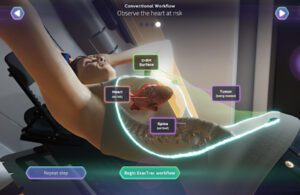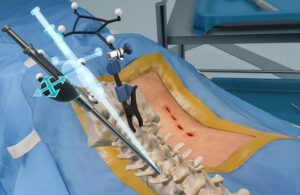
Level Ex’s Virtual Technique Guide for Brainlab’s ExacTrac Dynamic Deep Inspiration Breath Hold helps train physicians on advanced radiation therapy technology, which delivers high-precision treatments while sparing critical organs. [Image courtesy of Level Ex]
Device makers can accelerate the development of new skills and treatments for physicians by harnessing the power of video games.
Sam Glassenberg, Level Ex
Over the past three decades, a growing cohort of economists, psychologists, and designers have been successfully distilling the optimal neurochemical recipe for accelerating product adoption and driving skill development. They’ve been honing this approach by rapidly testing it on more than three billion consumers.
Their discipline is video game design. Through its evolution, they’ve successfully scaled the video games industry from a niche medium to an entertainment juggernaut.
The methodologies honed in video games are based in evolutionary neuroscience. When applied outside of entertainment they deliver equally impressive results. In recent years, medical device companies have begun leveraging these techniques to:
- Directly increase sales and accelerate conversion by helping surgeons experience the benefit of new devices on virtual patients;
- Increase usage of a device by increasing user confidence, highlighting underutilized features and helping medical professionals better understand which patients are indicated for its use; and
- Reduce abandonment resulting from device misuse and frustration by closing the specific skill and technique gaps that cause bad outcomes in the first place.
More recently, some forward-thinking medical device companies have used these techniques to optimize the devices themselves.
An introduction to the neuroscience of play
We’ll use the mass-market game Angry Birds as our example because it’s so well known. Have you ever wondered why Angry Birds is so addictive? It’s evolutionary. We’ve evolved to play these games, because this is how we learn.
Angry Birds is a physics puzzle that helps your brain develop a mental model for parabolic flight. Think back to the first time you played the game. You pulled the bird back in the slingshot, fired at the tower of pigs and probably missed. If you recall, the pigs laughed. At you. And that made you frustrated.
On the second shot, you aimed better but still missed. Frustration returned, yet motivated you to keep going. The third time, when you finally fired correctly, it was gloriously rewarding. Cartoon pigs exploded everywhere, accompanied by satisfying animations, audio and music. This was all deliberately designed to trigger a dopamine release in your brain to physically reinforce the same neural pathways you used on the last successful fire. That was how you learned how to play Angry Birds. That is the neuroscience of play in action.
The games industry didn’t invent this neuromechanic. This process is how our ancestors learned how to throw spears. They threw, missed, and were frustrated repeatedly until they hit the target — and released dopamine. Dopamine is a key part of human learning and triggering that release is one of many game mechanics and learning mechanics that game developers use. This is why medical video games can enhance a medical professional’s skills while being genuinely rewarding and inducing a physiological thrill.
While this is only one of a thousand tools in a game designer’s toolbox, medical device companies have discovered that you can use many of the same tools to help surgeons develop mental models for device usage.
Using the neuroscience of play to accelerate adoption of existing products

In this Level Ex Virtual Technique Guide, players are shown two different spine surgery techniques across workflows with the goal of educating them about spinal displacement and how to mitigate the negative effects. [Image courtesy of Level Ex]
Every medical device has its dopamine-filled “aha” moment when the surgeon realizes why they use that device. They can see something they otherwise wouldn’t be able to see, or understand a complication (such as brittle bone or physiological anomaly) for which the device is ideally suited.
The challenge is this “aha” moment typically occurs months or even years after the surgeon is introduced to the device. And these moments are often impossible to recreate on a cadaver.
Using game technology presenting precise patient scenarios, the surgeon experiences that “aha” moment on a virtual patient in the surgeon’s first interaction with a sales rep, at a conference booth, or through individual game play.
When used by sales reps at major medical device companies, these video games have been shown to increase lead conversion by 65%, improve device competency by 28%, and increase revenue by 6%. At conference booths, video games have been measured to triple booth traffic and increase opt-in rates for follow up by 60%.
These approaches have been validated across almost every major specialty, including orthopedics, neurosurgery, radiation oncology and cardiology.
Using the neuroscience of play to accelerate training

Level Ex’s Knee VTG, which allows physicians to collaboratively perform surgery together remotely from anywhere. [Image courtesy of Level Ex]
In the traditional medical device sales funnel, a physician can be lost many places along the journey. Despite the amount of time and resources invested in their training, a physician who makes a mistake in the early usage of the device is unlikely to pick up the device again.
Those specific skill gaps can be addressed using video games with just-in-time training done by a physician individually or collaboratively with a trainer. As such, gameplay is proven effective for improving adults’ work competencies, with studies demonstrating a 20% increase in self-efficacy, 14% and 11% better outcomes in terms of procedural and declarative knowledge, respectively, and 9% higher knowledge retention rates.
The practice of medicine is advancing through play
In 2022, surgeons in several specialties started playing with new devices inside virtual ORs simulated in the cloud with sales reps over Zoom and Microsoft Teams. They are scoring points based on time, blood loss and accuracy as they learn through play the benefits of a new device over the standard of care.
In 2023, this will expand to surgeons in nearly a dozen specialties. Devices that can be mastered independently with games that allow you to play with the product, understanding its function through the user’s own actions — this is what medical professionals will come to expect from medical device companies next year.

Sam Glassenberg is the CEO and founder of Level Ex. [Photo courtesy of Level Ex]
Sam Glassenberg, the CEO and founder of Level Ex, has spent his career leading teams and companies at the cutting-edge of the video game industry. Today his team at Level Ex harnesses video game technology and cognitive neuroscience to engage and train over 800,000 medical professionals.
The opinions expressed in this post are the author’s only and do not necessarily reflect those of MedicalDesignandOutsourcing.com or its employees.